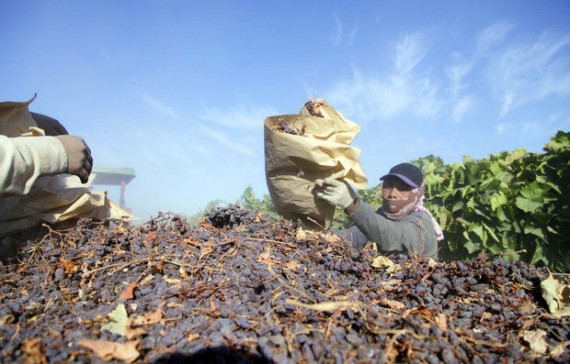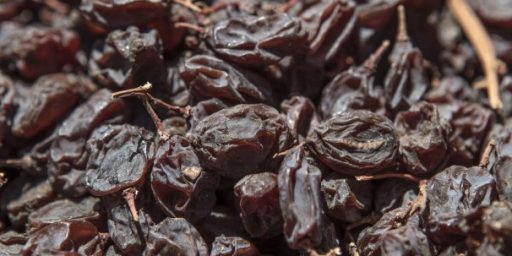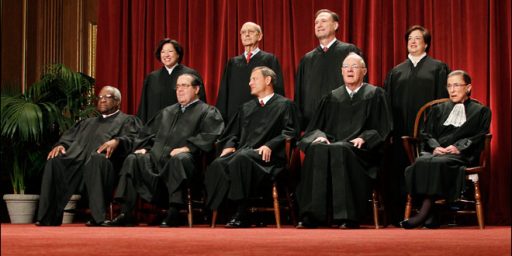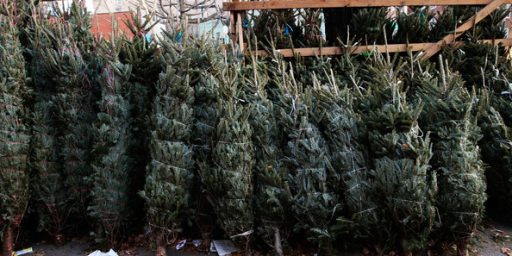Supreme Court Rules In Favor Of Raisin Farmers In Takings Case
The Supreme Court has struck down a program that forced farmers to turn over a portion of their crop to the government without compensation.

In a ruling that could have wide implications for several of the agricultural price support programs run by the Federal Government, the Supreme Court ruled today that an Agriculture Department program that required raisin farmers to surrender a portion of their crop without compensation was unconstitutional:
WASHINGTON — The Supreme Court ruled on Monday that a government program dating to the Great Depression meant to increase raisin prices by keeping some of them off the market amounted to an unconstitutional taking of private property by the government.
The case, Horne v. Department of Agriculture, No. 14-275, arose from the activities of Marvin D. and Laura Horne, raisin farmers in Fresno, Calif., who set up a business arrangement that they claimed allowed them to avoid the program.
The Agriculture Department imposed fines, and the Hornes defended themselves on the ground that aspects of the program violated the takings clause of the Fifth Amendment, which says private property may not be taken for public use without just compensation.
Chief Justice John G. Roberts Jr., writing for eight justices, said the program was indeed a government taking of private property.
He started by rejecting the argument that personal property is subject to different rules from real estate and the like. So long as there is wholesale government appropriation rather than taxation or regulation, he wrote, the same rules apply to both kinds of property.
Chief Justice Roberts added that it made no difference that the government in some years paid growers for some of the raisins kept from the market.
“The fact that the growers retain a contingent interest of indeterminate value does not mean there has been no physical taking,” the chief justice wrote, “particularly since the value of the interest depends on the discretion of the taker, and may be worthless, as it was for one of the two years at issue here.”
Chief Justice Roberts rejected the government’s argument, relying in part on a decision concerning pesticides, that raisin farmers dissatisfied with the marketing program remained free to plant different crops.
“‘Let them sell wine’ is probably not much more comforting to the raisin growers than similar retorts have been to others throughout history,” the chief justice wrote.
“Selling produce in interstate commerce, although certainly subject to reasonable government regulation, is similarly not a special governmental benefit that the government may hold hostage, to be ransomed by the waiver of constitutional protection,” Chief Justice Roberts added. “Raisins are not dangerous pesticides; they are a healthy snack.”
He went on to dismiss as irrelevant a case about a government program concerning oyster shells. “Raisins are not like oysters: they are private property — the fruit of the growers’ labor — not ‘public things subject to the absolute control of the state,'” he wrote, quoting the earlier decision. “Any physical taking of them for public use must be accompanied by just compensation.”
In ruling that the Hornes were indeed entitled to compensation, Chief Justice Roberts’s majority narrowed. On that point, he was joined only by the other more conservative members of the court: Justices Antonin Scalia, Anthony M. Kennedy, Clarence Thomas and Samuel A. Alito Jr.
“The Hornes should simply be relieved of the obligation to pay the fine and associated civil penalty they were assessed when they resisted the government’s effort to take their raisins,” the chief justice wrote. “This case, in litigation for more than a decade, has gone on long enough.”
Justice Stephen G. Breyer, joined by Justices Ruth Bader Ginsburg and Elena Kagan, parted ways with the majority on that last point. The program’s benefits should be weighed against its costs, Justice Breyer wrote. He would have returned the case to the lower courts for a determination of whether the program helped or hurt the Hornes, and how much.
In a concurrence, Justice Thomas said such a move “would be a fruitless exercise.”
Those of you familiar with the Court’s history will notice the similarities between this case and a case from the New Deal Era called Wickard v. Filburn which dealt with an agricultural relief program not unlike the raisin price support program at issue in this case. In that case, the issue before the Court was whether Congress had the authority to regulate a farmer’s growing of wheat on his own land for his own use rather than the Takings Clause issues before the Court here. What was before the Court, though, was the same type of price support mechanism that the Federal Government used to manipulate the agricultural economy for nearly past eighty years and, as Lyle Denniston notes, the Court’s ruling does raise questions about what might be in store for other programs that use the same methods that the raisin program did:
One of the more durable legacies of Franklin Roosevelt’s New Deal in the 1930s was the idea that the farm economy can be bolstered by paying growers to keep some of their crop off the market, or paying them not to grow some of it at all. One of those programs ran into a high constitutional fence on Monday, raising at least some question about how long the idea can continue unchanged.
Depending on how farmers, and their lawyers, interpret the new decision in Horne v. U.S. Department of Agriculture, it could pose a threat to a wide range of government subsidy programs that seek to keep crop prices up by keeping supply down. That formula has been used since 1949 for the California raisin industry under a 1937 farm law, but its future is in doubt. What happens to other farm regulatory programs will have to await further development.
The feature of the raisin program that a Court majority condemned constitutionally is that growers are required to turn over full control of a part of their annual crop to the government, to be held off the market temporarily to push up prices for the annual crop as a whole. Whether the growers get anything back, after the government finds ways to dispose of those put in the set-aside bin, was the feature that led the majority to say it is a form of government seizure for which the growers must get fair compensation under the Fifth Amendment.
(…)
[Justice Sonia Sotomayor, in dissent argued] that the raisin growers were not deprived of all of their ownership interests in the raisins that they had to hand over, and thus there was no “taking.” Sotomayor disputed the majority’s claim that it was not threatening other forms of agricultural subsidy programs, ones that do not have the takeover of full control of the set-aside part of the crop.
The Department of Agriculture has said that there are seven existing programs, including the one for raisins, that operate on the set-aside principle, in which the farmer loses control of the crop turned over to the Department. The others involve California almonds, dates, dried prunes, and walnuts, plus tart cherries grown in seven states and spearmint oil produced in five states.
Chief Justice John G. Roberts, Jr., in writing for the majority, said that the Court was only dealing with a situation in which the owners of the raisins actually had the raisins taken away from them and put under government management. That was the equivalent, Roberts wrote, of the government physically taking over private property just as if it had seized the raisin growers’ land. The Constitution makes no distinction, the main opinion said, between complete government takeover of real estate and personal property.
The parts of the Roberts opinion that condemned the raisin program seemed to make it at least arguable that a farm program regime that merely regulated how much of a crop could go to market, instead of putting it totally under government control, might not offend the Constitution.
At The Volokh Conspiracy, Ilya Somin calls it a victory for property owners:
The Court ruled in favor of the property owners by an 8-1 margin on the most significant issue at stake: whether the government’s appropriation of the raisins is a taking. Only Justice Sonia Sotomayor dissented.
This is an extremely important result, because it rejects the government’s dangerous argument that the Takings Clause offers less protection for personal property than for real property (the legal term for property in land), which had been embraced by the Ninth Circuit lower court decision. For reasons elaborated in detail in an amicus brief I joined along with other constitutional law and property scholars, the government’s position on this issue was deeply at odds with the history and original meaning of the Takings Clause. Indeed, as the Court notes, the Clause was adopted in part as a reaction to abusive British confiscation of personal property during the colonial era and the Revolutionary War.
(…)
The Court further emphasized that “[t]he reserve requirement imposed by the Raisin Committee is a clear physical taking. Actual raisins are transferred from the growers to the Government.” That makes it an automatic per set aking, that requires compensation. Indeed, if anything qualifies as a taking of private property, it is a situation where the government takes physical control of the property in question and, as Roberts puts it, “Raisin growers subject to the reserve requirement thus lose the entire ‘bundle’ of property rights in the appropriated raisins— ‘the rights to possess, use and dispose of’ them.”
The majority also rejected the government’s argument that there was no taking because the Hornes and other raisin growers sometimes receive part of the proceeds of the government’s sale of the appropriated raisins in international markets. As the majority opinion explains, “The fact that the growers retain a contingent interest of indeterminate value does not mean there has been no physical taking, particularly since the value of the interest depends on the discretion of the taker, and may be worthless, as it was for one of the two years at issue here.” While the money paid to the owners of the raisins might reduce the amount of compensation they are due, it does not change the fact that their property has been physically seized by the government, which means that a taking has occurred.
Horne v. Dept. of Agriculture was not among the high profile cases that the Supreme Court heard this terms, although I did make note of it in my preview of pending cases at the beginning of the month. Despite that, though, the Court’s ruling has the potential to have a wide-ranging impact on a variety of government programs, and could have a real impact on agriculture prices going forward. As both the Majority Opinion and Justice Sotomayor’s Dissent note, there are at least seven programs run by the Department of Agriculture that operate in the same manner as the raisin program at issue here. The basic logic of the program, of course, is that the government is “helping” farmers by forcing them to withhold a portion of their crop from the market because that helps reduce the available supply and keep prices at a certain level. As the Plaintiff’s in Horne noted, though, the real impact of the program was two-fold. First, it tended to work mostly to the benefit of the large farming conglomerates who produced most of the raisin’s that went to market domestically by reducing the competition they faced from smaller farmers and reducing the supply available to buyers, which of course kept the price artificially high. The second problem with the program, and the one that proved to be constitutionally fatal, is the fact that farmers who turned portions of their crop over the government were not compensated for the value of what they had to surrender. At some point, apparently, they would receive some portion of whatever the Department of Agriculture received from selling this part of the crop on the international market, but as the Court noted in its opinion,this amount was not tied to the market value of the crops at the time they were seized and therefore cannot be considered to come close to the “just compensation” required by the Takings Clause of the Fifth Amendment. To the extent there are other Department of Agriculture programs that work in a similar fashion, it seems fairly clear that they will be found to be similarly Constitutionally deficient unless they are reformed significantly.
On its merits, it seems fairly clear that the Court got this case right. The language of the Takings Clause is fairly unambiguous, and there is no question that the program in question was taking property. The only real question seems to have been compensation, and on this point the majority was again correct in noting that whatever portion of the proceeds of overseas marketing that farmers received from the program was, at best, merely partial payment for the compensation that the farmer’s should have received for the initial seizure of their property. The best measure for that amount, of course, would have been the market value of the crop at the time of the seizure, although admittedly that amount will likely change now that the government will not be withholding crops from the market, that price will drop to some extent. At the same time, though, farmers will be able to receive the full market value of their crops rather than being forced to surrender a portion of it to the state for the promise of possible future payment. Additionally, of course, programs like this are likely to benefit consumers since they will lead to lower market prices for raisins and products that use raisins, as well as other commodities that might be covered by other Department of Agriculture programs. There will obviously be a period where farmers, processors, and suppliers will be adjusting to this new world, but that will be a small price to pay for elimination of a program that never should have existed anyway.
Here’s the opinion:






No one can stand against Big Raisin.
Wickard is one of the “dirty dozen” cases that Robert Levy identified as one of the worst of the 20th century. I’m glad to see the Court finally moving in the other direction on that. And if it helps erode our expensive, idiotic “Moscow on the Mississippi” farm program, so much the better.
Awesome. Get rid of all the price support programs so we can go back to boom and bust in agriculture just like we have in banking.
By increasing price support, the remaining raisins sold were of higher value also partially compensating for the takings albeit indirectly.
I wonder whether this decision while legally and constitutionally correct will result in additional damage to the farmers. They may have lost by winning.
Great, more raisins. Yuck.
https://www.youtube.com/watch?v=_PNPw5ozU0U
a raisin here, a raisin there – next, the slippery slope of …
Coming soon to OTB headlines: “Raisin farmers losing tens of millions of dollars to asset forfeiture programs”
Everybody who understands the free market wants a free market. Of course, they want a free market for everybody except themselves. For their own enterprise, they want rules, regulations, certification programs, licensing, and government support in the form of insurance, infrastructure, and welfare payments to their employees to keep wages low. Also, everybody wants the government to assume the cost of externalities like clean water and air. I will believe that the farmers in Fresno are believers in free markets when they come out in favor of open markets for the price of water.
This does not mean that that I disagree with the ruling, but we must understand that a document written by a agricultural society might have problems fitting into the challenges of our industrial world. I think that the free market as an ideal has been undercut far more by business interests playing the regulatory capture game than by pinko radicals who have actually been ineffectual.
Cop – “We didn’t take all of your money, we left you a few dollars.” = not a taking.
Sotamayor is in over her wise Latina head.
Aww, how cute: Mr. Introverted Grump has learned how to make a joke.
Look, it was settled law. It was the Law Of The Land. Why was this even ever accepted? Why couldn’t the bitter losers just get over it and move on?
Seriously, how the hell could anyone justify this in the first place? Oh. FDR, New Deal.
I withdraw the question.
@Hal_10000:
Wickard actually has little connection to this ruling. In Wickard, the farmer was fined for violating production quotas, but kept his wheat. That’s a decidedly different scenario than the raisin program.
I’d note as well that this ruling does NOT preclude takings, nor does it ensure speedy payment of recompense in the event of a taking. I suspect that the outcome will be a change in operational methods, not a change in program goals.
Central Valley raisin farmer here. All raisin farmers have suffered threw this a very hard time in the industry. One farmer recently bloged he went from farming 1700 acres down two 100 acres, myself 200 to 20 acres. But the worst times leading up to this started in the early 1980s. The worst being 1994 as we were required to set aside (put into reserves) 53% and we got 0 return. At this time there was a gradual take over of the powers to be with in the R.A.C. They developed lots of different programs that (excuse the pun ate raisins) that the packer made money on but nothing or very little got back to the grower. I am surprised my son wants to farm. Our goverment wants only big farmers that contribute to the political campaigns and we are loosing great numbers of young people to the family farm.